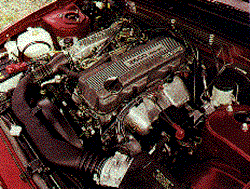| It takes to twisty road like macaroni to Tupperware... | |||
| Back when the 510 wowed econo-minded sports-seda
enthusiasts with its overhead-cam engine and 4-wheel indt pendent suspension; when the
240Z was a sellout its first two years on dealer lots and dubbed by Road & Track as
one of the "10 Best Cars in the World"; when the 520 pickup truck create a whole
new market for rugged, nimble mini-pickup trucks Back when Nissan was Datsun. It's been four years now since Nissan decided to dump its old Datsun moniker in the U.S. and market cars under the parent company's name. And in the interim, Nissan has tasted the bitter pill of a declining market share; a conservative, play-it-safe product with me-too styling; a loss of direction and mixed message for the 240Z's successor and Nissan performance luxury flagship, the 300ZX; pnce pressure on bread-and-butter sedans from Korean and other Third World-assembled cars; and a steadily rising yen. All of that hand-wringing is about to end. You see, Nissan has a revitalization plan under way with four all-new products for 1989. And Step One is to stir up the low/medium-priced sports/GT ranks with the successor to Nissan's long-running 200SX, the 240SX. Three little numbers-a two, a four and a zero. That designation worked magic for Datsun in the early Seventies (with a Z suffix tacked on for good measure), and if you overlook that 240 is equally synonymous with a long-lived line of conservative Volvo sedans and wagons, it's reasonable to assume that tagging Nissan's new sports/GT thusly will evoke positive memories and maybe even create some new excitement. How's this for starters? The 240SX is (drum roll, please) a rear-driver. It's endowed with a sleek, wind-cheating body worthy of a 0.30 Cx aerodynamic drag rating and independent rear suspension derived from the Nissan MID-4 mid-engine concept sports car. Inside, there's a wonderfully fluid dash layout and cockpit configuration reminiscent of the Nissan ARC-X show car. And, get this, pocket-rocket fans: Nissan's going to bring it in at less than $ 15,000 - much less if the yen/dollar exchange rate stays at current levels. Based on the all-new, 5th-generation Japanese home-market Silvia, the 240SX is longer and wider than the 200SX it replaces, giving it a sleek, new look. And compared to last year's 200SX top offering, the SE V-6, the new car is some 200-300 lb lighter, depending on option selection. This weight saving is an important power-to-weight factor because the U.S.-bound 240SX is available with 2.4 liters of normally aspirated 4-cylinder power only. Nissan wanted it that way. Recent exorbitant increases in U.S. auto liability-insurance rates for young buyers of sporty cars has hurt sales dramatically. Selecting the box that says V-8, V-6, twincam, supercharged, turbocharged or even four valves per cylinder can get very expensive these days. As with the former 200SX, two body styles of the 240SX will be available: a formal notchback XE and a performance fastback SE. The luxury-oriented XE looks like a scaled-down Acura Legend coupe, especially from the rear three-quarter view. The SE hatchback is dominated by a thick B-pillar, reminiscent of the 1975- 1980 Chevy Monza. Both models feature a specific-to-the-U.S. front-end treatment with pop-up headlamps similar to the Nissan Pulsar or Ford Probe. The rear is dominated by a large, light-bar taillamp treatment curving downward at each end, |
All in all, the new 240SX is an attractive, well-rounded, well-integrated shape - one that doesn't suffer from some of the styling excesses of more recent Nissans. But is it as distinctive and immediately recognizable as the original 240Z? Is it a car of classic proportions in the Jaguar XKE idiom? To a extent the 240Z's long-hood, short-deck styling was dictated by its inline-6 engine, short wheelbase and lack of rear seats. That car has now grown in performance, luxury content and price into today's 300ZX, which the 240SX does not replace. Where the 4-cylinder, 2 + 2-seat 240SX does, in fact, harken back to the original 240Z is in performance. As the "At a Glance" specifications box shows, performance of our prototype 240SX was on a par with or superior to the original Datsun 240Z. The heart of the 240SX is a somewhat undersquare 2389-cc sohc inline-4 that's basically the bulletproof Nissan Hardbody truck block with a freer-breathing 3-valve-per-cyl head (two intakes and one exhaust) and with a tuned-runner intake manifold grafted on. Nothing exotic there. At 140 net bhp, it develops roughly the same power and torque the original 240Z's 2393-cc sohc inline-6 when you take into account that the 1970 Z's 150 bhp was measured as SAE bhp, minus all power accessory drives. Of course, the 240SX's 4-cylinder isn't as smooth as the Z-car's inline-6. Large displacement 4-cylinder engines never are. And Nissan didn't resort to expensive counter-rotating balance shafts to smooth things out either. Instead, 240SX engine vibrations are dampened by building in rigidity (by means of a 1-piece main-bearing girdle) and by using soft fluid-filled engine/transmission mounts. The Iatter causes more driveline judder on hard shifts and sudden throttle applications than most staffers like. But overall engine is tractable and develops good low- and midrange torque, becoming thrashy only above 5500 rpm. Shifting of the direct-acting 5-speed manual gearbox with double-cone synchromesh is superb, a refreshing change from the remote shifters on many front-drive competitors. An electronically controlled 4-speed automatic transmission is optional. As for the 240SX's handling, it is light-years ahead of the 240Z, a car not known for its high-speed agility or stability. The 240SX exhibits an uncanny balance of good stick with excellent impact harshness. Dive and squat are well-controlled, just enough body roll to let the driver know he's approaching the car's 0.82g limit of adhesion. The car's 53-percent front/47 percent rear weight distribution is nearly ideal. With the standard power-assisted steering, turn-in is crisp, not overboosted. |
||
